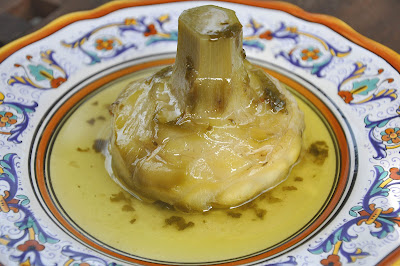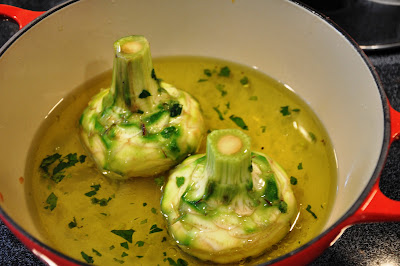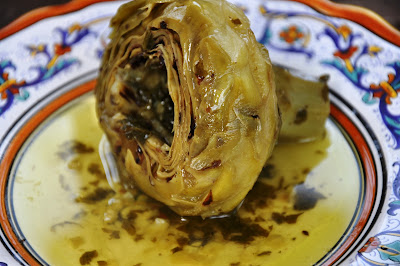Dear readers: I am back from my travels, at my blogging post just in time for the first day of Spring. Artichokes are back in season! And is there any vegetable more typical of Roman cooking, perhaps of all Italian cuisine, than the artichoke? What better way to get back to work, then, than this dish, one of the most typically Roman ways to prepare artichokes called, appropriately enough, alla romana, or 'in the Roman style': stuffed with garlic and herbs, and simmered in olive oil and water. Nothing could be simpler, or more flavorful.
The only tricky part of this dish, like any artichoke dish, is the initial trimming of the artichoke. Much of a mature artichoke—the outer leaves and the inner core or 'choke'—are inedible, and the Italian way with artichokes is to trim them of all their inedible parts before cooking them. In Rome, many markets, including the famous Campo de' fiori market near our place, would sell you pre-trimmed artichokes—at a higher price, of course—which saves you the trouble, but elsewhere you'll need to do it yourself. The operation is not all that difficult, but it takes some practice to get the 'hang' of it:
First, remove all the tough outer leaves from the artichoke. Beneath, you will find thinner, lighter colored leaves that you should leave on. Cut off the tip of the artichoke. Then, taking a very sharp, solid paring knife, begin to pare away the sides of the artichoke, starting from the wide base, holding the artichoke in one hand and rotating it as you pare away with the other hand, as if you were peeling an apple. Then, taking a spoon, scoop out the fuzzy core or 'choke' of the vegetable, including the thin, spiny leaves (often a dark purple color) that often surround the choke. Wash the artichoke well under cold running water to remove any of the 'fuzz' that tends to stick to the vegetable. Then cut off all but 3-4 cm (1-1-1/2 inch) of the stem, and pare away its tough, fibrous outer layer. All the while as you are paring the artichoke, you should make sure to rub it the exposed side of a lemon that you have sliced in two, to prevent discoloration.
For a nice step-by-step visual guide to trimming an artichoke, see this article (the explanations are in Italian, but no matter: the photographs will show you the way).
After you are through trimming, immediately drop the artichoke into a large bowl of acidulated water to prevent discoloration. Proceed in the same fashion with the rest of your artichokes:
You are now ready to staff and cook your artichokes: Make a tritto of garlic, parsley and mint, mixed with salt and pepper and wet with a bit of olive oil. Stuff the hallowed out cores of the artichokes with this mixture. Then stand the artichokes up, stems upward, in a terracotta casserole or enameled cast iron Dutch oven or other heavy pot with tall sides. Add a generous amount of olive oil and then enough water to come halfway up the artichokes (not counting the stem):
Season with salt and pepper. (Although not part of the traditional recipe, I also like to add an extra sprig of mint and garlic clove to the liquid.) If you have any extra garlic-and-herb stuffing, you can add it to the liquid as well. Cover the pot and let the artichokes simmer for about 30 minutes. Check for doneness with a knife; they should be tender but not 'mushy'. Allow the artichokes to cool before serving, moistened with a bit of the liquid.
NOTES: This recipe calls for the larger sort of artichokes known as 'globe' artichokes, known as mammole in Italian. When an artichoke is fresh, its leaves will cling tightly to the vegetable and show no sign of discoloration. Unfortunately, it is rare to find such fresh specimens in US markets (California, where most artichokes in the US are grown) might be the exception) but this treatment works well even with less than perfectly fresh artichokes. Slightly smaller artichokes will also work—and will cook in less time—but 'baby' artichokes will not.
Carciofi alla romana are very versatile. They can be an antipasto, a secondo for a vegan/vegetarian meal or even a light lunch or supper. They are one of the two most typically Roman ways of preparing artichokes, the other being carciofi alla giudia, or "Jewish style" artichokes, which I will blog about soon.
Post scriptum: By the way, I never throw away the cooking liquid. It is perfectly delicious and, although it is perhaps not very orthodox, I like to serve the liquid, too, at table, for dipping with nice crusty bread.



